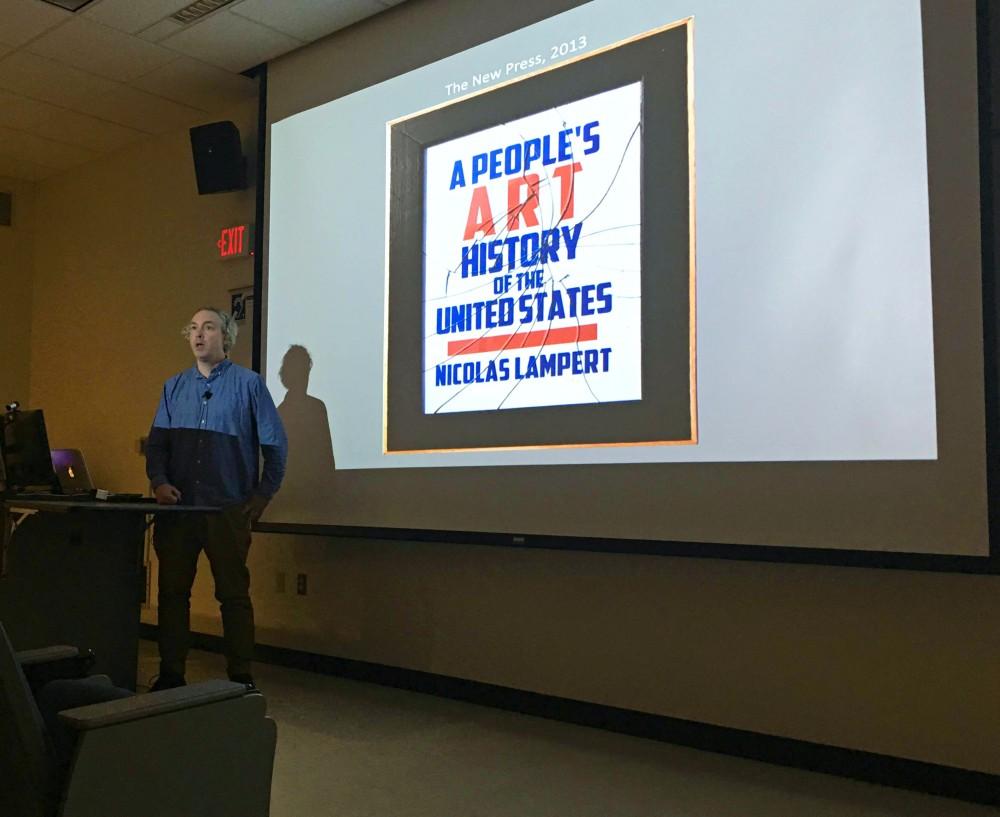Activist Nicolas Lampert lectures at GVSU

GVL/Kate Branum – Nicolas Lampert lecture
Nov 14, 2016
The Grand Valley State University art and design department invited Milwaukee-based interdisciplinary artist and author Nicolas Lampert to host a lecture Monday, Nov. 7 in Lake Huron Hall as a continuation of the “art and the radical” lecture series.
“Art and the radical” is a visiting artist series designed to deepen understanding of the world by revealing alternative histories and highlighting marginalized communities and their widely held beliefs and traditions.
Lampert is a full-time faculty member in the department of art and design at the University of Wisconsin-Milwaukee with a joint appointment in printmaking, writing and critical thinking.
“(GVSU) chose (Lampert) to visit campus for two main reasons,” said Brett Colley, associate professor of printmaking and drawing. “He provides an inspiring and highly accessible role model of an artist using their skills to directly engage with social justice issues. He is (also) an excellent example of an artist and intellectual who isn’t constrained to working in just one way, with only one medium.”
For the past 25 years, Lampert has practiced activism and social justice as a graphic design artist, writer and theorist. His artwork has been shown around the world and can also be found in the collection of work at the Museum of Modern Art in New York.
Lampert has worked with activists and artists from several large campaigns like TAMMS Year 10, where he fought alongside artists to shut down Tamms Correctional Center in Illinois, Iraq Veterans Against the War, a cause dedicated to ending war and the stigma around post traumatic stress disorder in veterans, the Rainforest Action Network, an environmental organization in California and Voces de la Frontera, Wisconsin’s leading immigrant rights and low-wage worker center.
Recently, Lampert has transitioned from a mainly individual studio practice to work that is rooted deeply in community. He works tirelessly to organize art campaigns at the street level, bring relevant social and environmental issues out into the open.
During his lecture, Lampert discussed his book, “A People’s Art History of the United States: 250 Years of Activist Art and Artists Working in Social Justice Movements,” published by The New Press in 2013.
Gathering inspiration from the work done by Howard Zinn, an American historian, playwright and activist, Lampert wrote “A People’s History of the United States” with the intention of portraying a democratic vision of art–a principle he follows when creating his own designs. He strongly believes art does not just belong within the confines of museums and archives, rather, art should be geared toward the community.
“Writing this book, I really wanted to do a how-to manual for activists and artists to understand that (art) history is very deep and very rich,” Lampert said.
Collectively, Lampert works with three groups: the Justseeds Artists’ Cooperative, a worker-owned printmaking cooperative of 30 artists from all across the country, ReciproCity, a mobile experimental cultural center focusing on community activism, and Climate Prints, an activist project that shares downloadable graphics on Climate Justice.
Lampert shared examples of his graphic design work created for campaigns. He is largely influenced by bold graphics of the past. His designs are intentionally controversial to spark conversation out in the community.
“I think (activist) tactics can be reused and shared and a lot of the tactics activist artists are using are designed to spur public discussion,” Lampert said. “How do you use tactics to get art to enter the bloodstream of the media to get people talking about it?”
Drawing on themes such as minority oppression, mass incarceration and police brutality, Lampert aims to challenge viewers to think deeply about important issues in society. He made it clear that his art isn’t completed with the intention of getting his name out, instead, it is all done for the greater good of the community.























